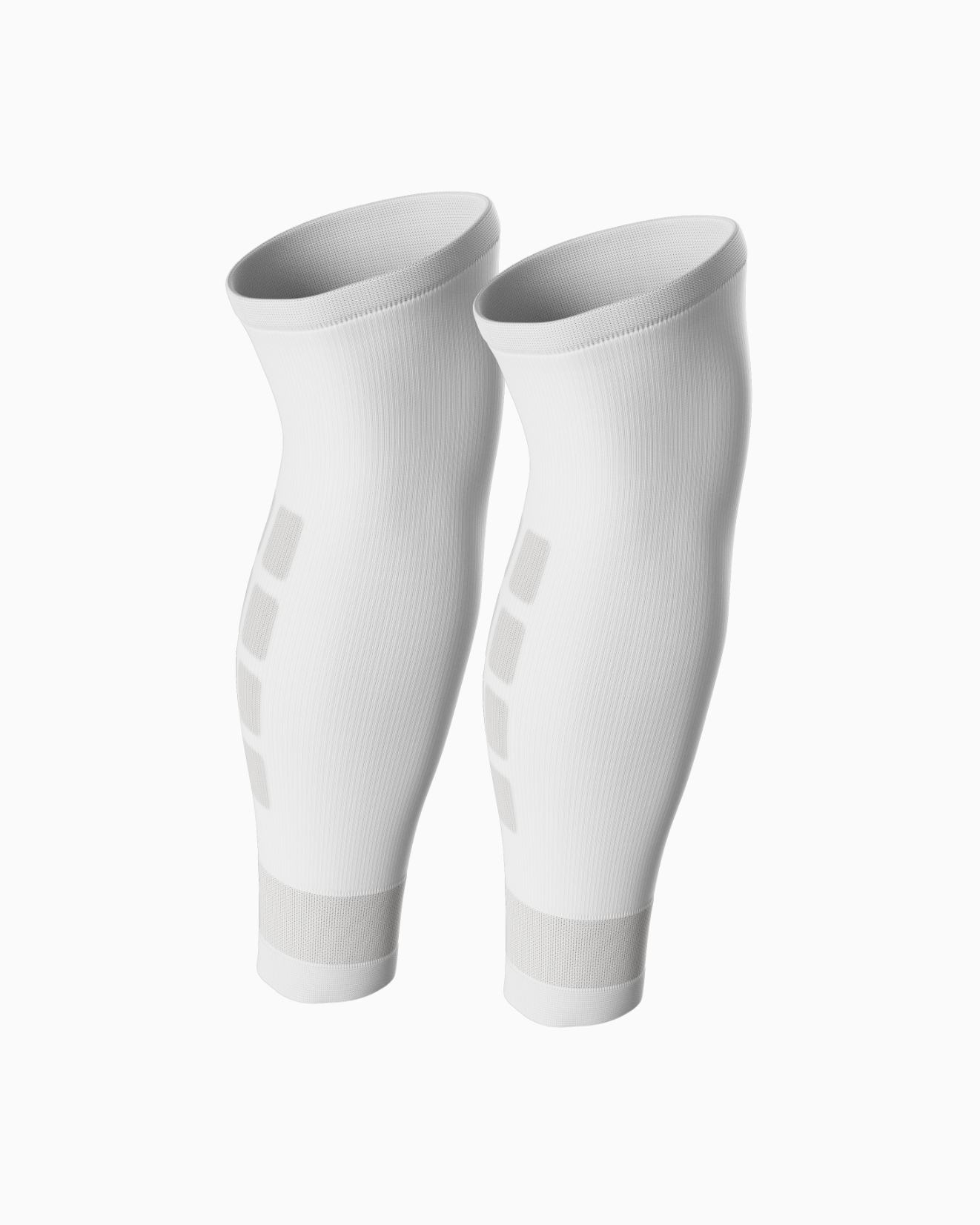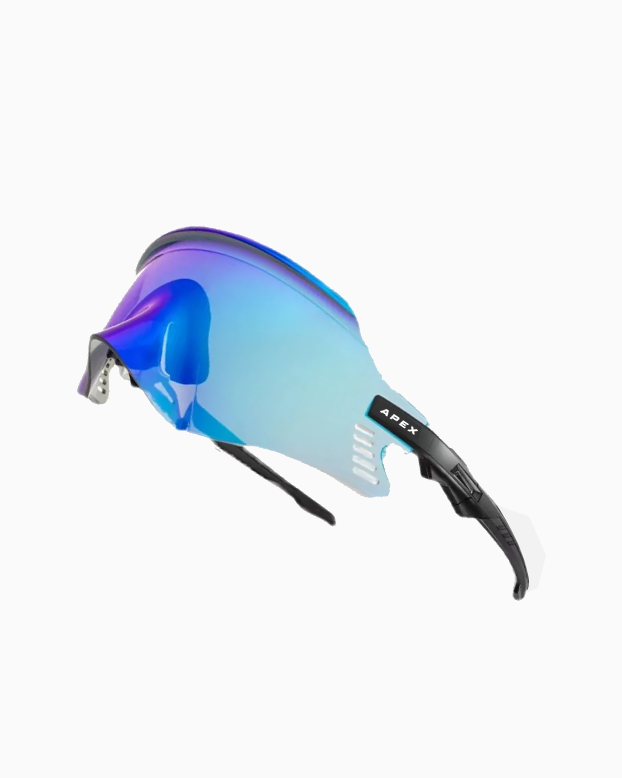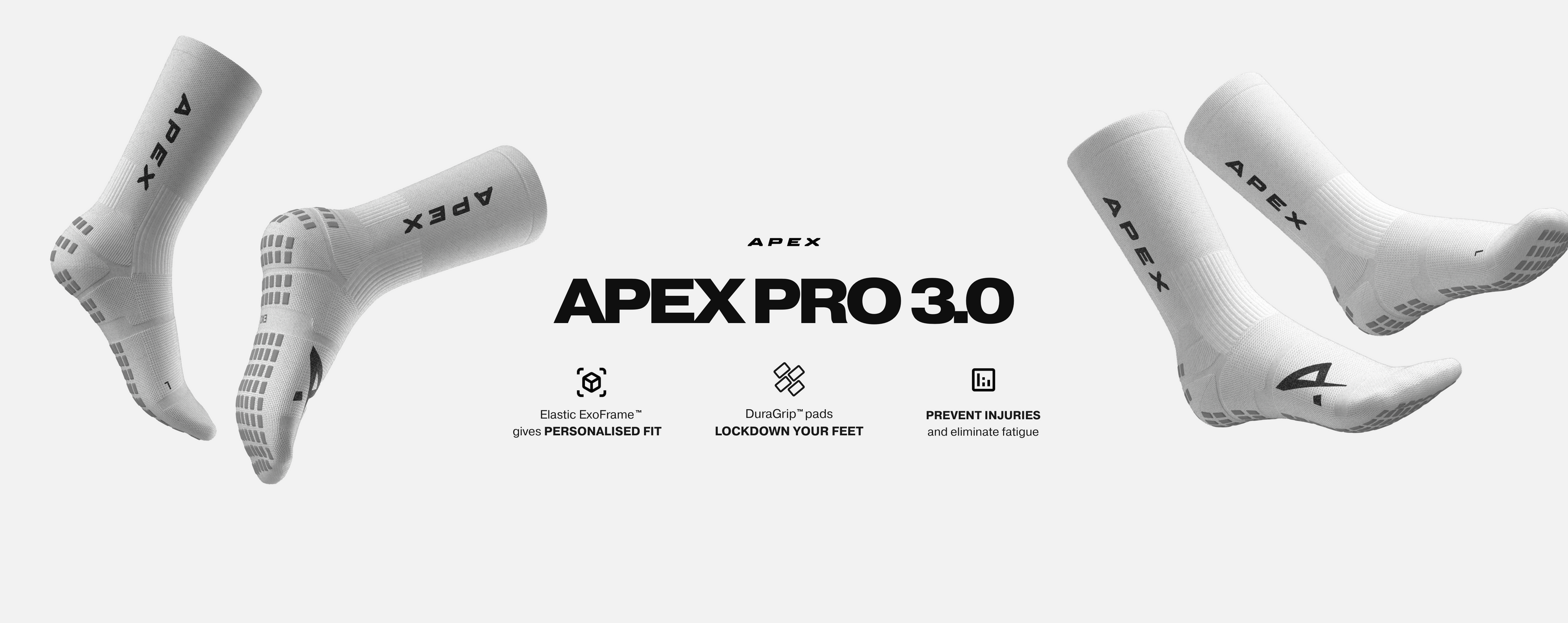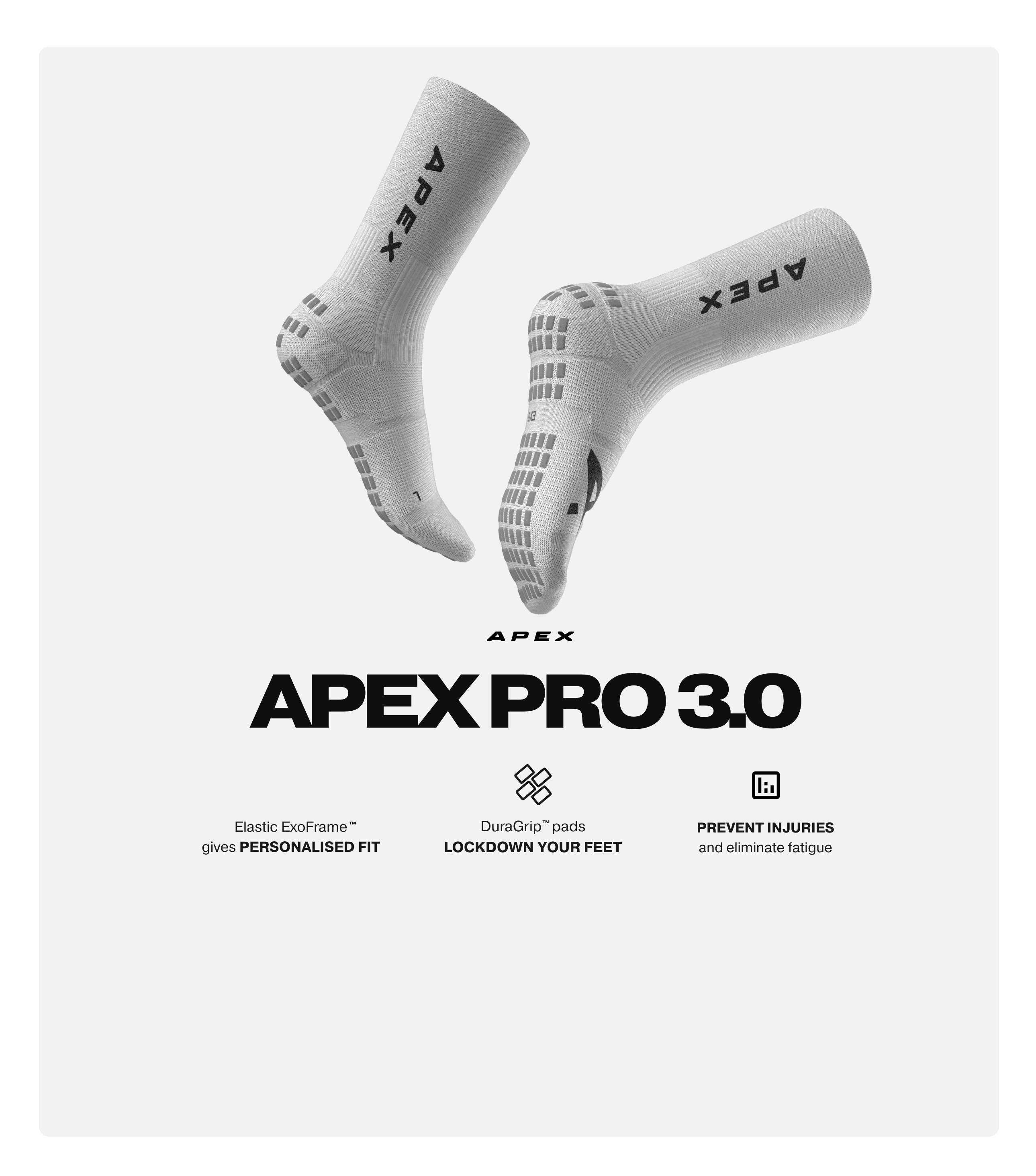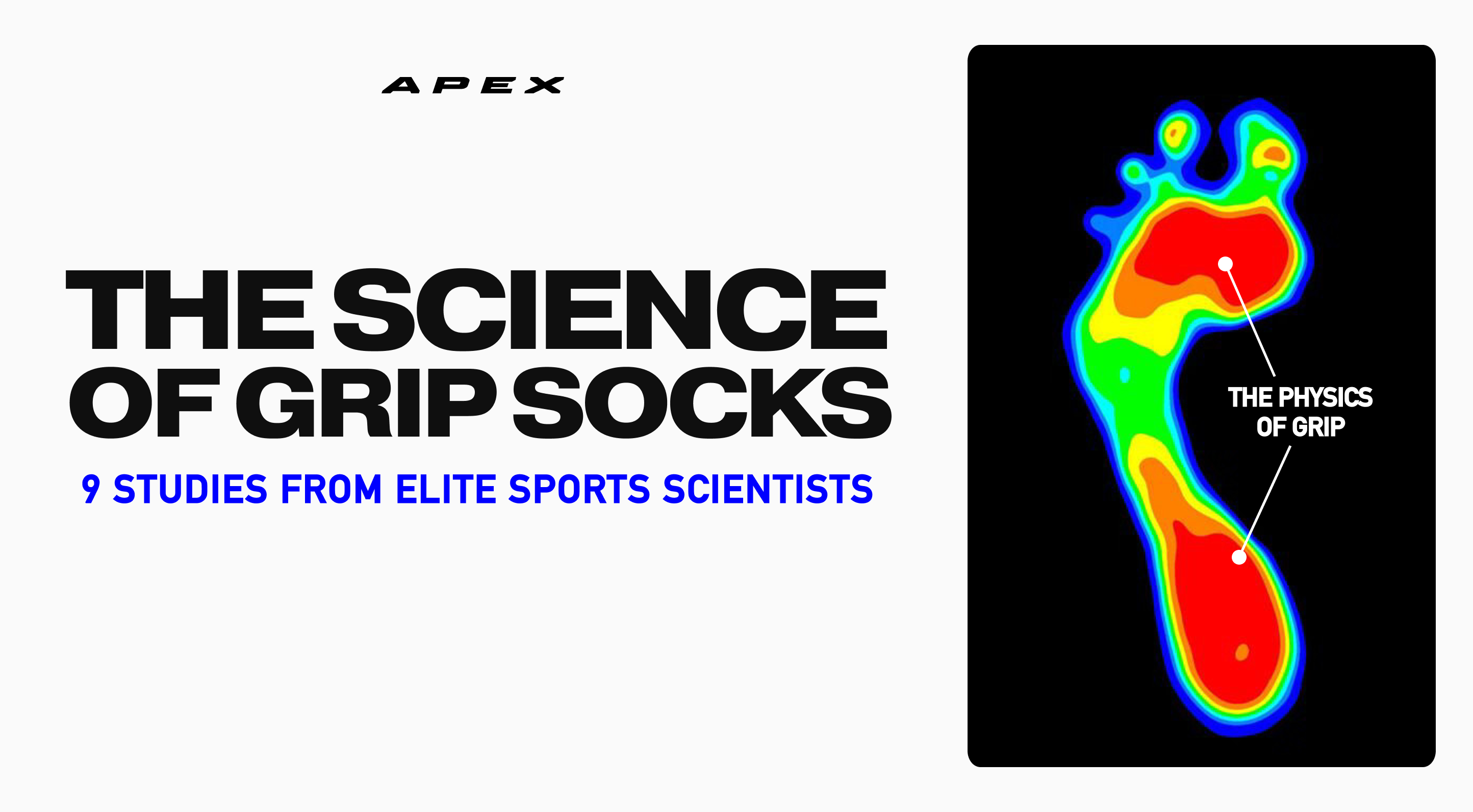Footballers obsess over fresh new boots, the changing room playlist, and the hallowed team celebration. But one overlooked piece of vital equipment plays a much bigger role than most athletes realise.
Socks.
More specifically (in our case) football grip socks.
Over the last decade grip socks have become hugely popular. From the earliest iteration of the TRUsox 1.0 back in 2011, to the latest assortment of cheap trash imported from China - you’ll see them on Premier League pros, academy players, semi-professionals, and beyond into the world of Sunday League legends and 5-aside-masters.
The idea is a simple one: lock the foot down inside the boot - get faster, more agile, increase stability, reduce injury.
But do grip socks actually work? And not only that, are the ones you’re wearing actually any good?
The short answer is yes. And probably not.
The longer answer, backed by recent nerd-reviewed studies, will show you why wearing grip socks as a footballer is becoming a standard no-brainer for finding that extra 0.1% performance boost we’re all after.
What Are Grip Socks and Why Do Footballers Wear Them?
When you sprint, turn, accelerate or shoot, the foot experiences different forces inside the boot.
If your foot moves even a few millimetres beyond the natural shift you HAVE to experience to retain mind to body proprioreception, you’re losing speed and power, as you’re energy is inefficiently transferred from muscles, to feet, to boots, to ground. In football, milliseconds matter.
When in-boot movement occurs:
❌ Acceleration force is wasted
❌ Stability decreases during planting and turning
❌ Touch and striking accuracy become inconsistent
❌ Blister risk increases
Grip socks are designed to lock the foot to the inside of the boot, improving energy transfer and movement efficiency. And there are a long list of recent studies that prove this is the case:
Study #1: Grip Socks Improve Agility and Reduce Foot Slipping
A 2022 study on 29 male and female team-sport athletes examined agility performance while wearing grip socks vs regular socks.
The key findings from this study showed that:
- Grip socks had a higher friction coefficient against the insole compared to standard sports socks;
- Athletes ran slalom agility courses significantly faster (p = 0.001), and;
- Forefoot sliding was reduced during sharp turns and braking.
Importantly, these improvements didn’t come from the boot gripping the turf. Instead, the improvements came purely from internal stability, where it matters most.
This means that grip socks enhance how the foot interacts with the inside of the boot, not how the boot interacts with the ground. By minimising unwanted micro-movements between the foot, sock, and insole, players can transfer force more efficiently.
In practical terms, that extra stability means faster reaction times, better dribbling, and more consistent acceleration when weaving through defenders.
The researchers concluded that the socks effectively “locked” the foot into the boot during high-intensity movements, reducing wasted energy and improving overall movement efficiency.
Study #2: Grip Socks in Football-Specific Agility
A 2023 study took 19 male footballers through a 26-meter agility course that simulated a number of football-specific movements (e.g. direction changes, accelerations, etc.).
While not every player saw identical performance improvements, the results highlighted something important:
Grip socks help the athletes who need them most.
The researchers saw that players who naturally experienced more foot slip inside their boots benefitted the most when wearing high-friction socks.
For instance, if you tend to have a little bit more slip inside your boot during a match, grip socks will massively improve your agility, demonstrating that grip socks provide a targeted performance advantage for athletes who struggle with internal foot movement.
And, the study said that unless you have a boot that’s perfectly moulded to your foot, you’re most likely going to need grip socks (which is pretty much everyone…)
Plus, even when players didn’t notice a huge improvement in agility from using the grip sock, force-plate data showed that grip socks altered how the foot loaded the boot during directional changes. This supports the idea that grip socks make movement more efficient, more stable, and more controlled.
Think of grip socks as performance insurance, guaranteeing internal stability when you need it most.
Study #3: Grip Socks Improve Dribbling and Ball Striking
A 2023 paper tested football grip socks on 20 collegiate soccer players using both performance tasks and in-shoe pressure analysis.
The results showed:
- Grip socks improved dribbling speed (p = 0.02)
- Grip socks increased the number of touches when juggling a ball (p = 0.03)
- Grip socks significantly improved shot accuracy across short, medium, and long distance shots
This is massive.
Most people assume grip socks only matter for agility. But, this study found that grip socks also improve technical skill too.
The researchers said this happened because when the foot is more stable, proprioception improves. The brain knows exactly where the foot is inside the shoe - think of it as a form of enhanced neuromuscular precision. If you don’t have micro-slippage inside the boot, contact with the ball becomes a lot more predictable.
In short, cleaner biomechanics = cleaner technique. This is what grip socks offer you.
Study #4: Grip Socks Change In-Shoe Force Mechanics
Another 2023 study specifically looked at the biomechanics inside the boot during explosive movements by measuring force patterns during repeated 180° shuttle runs.
The results of this study were very interesting:
- Grip socks changed force-transfer mechanics inside the boot: players wearing high-friction socks showed different and more controlled impulse patterns against the shoe upper. This is a clear sign that the foot was more stable and the boot was responding more directly to the athlete’s movement.
- Movements were more efficient: Some athletes hit the same shuttle-run times, but they achieved those times with cleaner biomechanics, meaning less wasted motion and more efficient force production.
Traditional testing (just measuring speed or time) can often miss what’s happening inside the boot. So this study is great because it shows proper data on how grip socks help the body move more efficiently, even if stopwatch readings don’t instantly reveal it.
It also suggests something very positive for long-term performance and injury prevention. Better internal mechanics mean lower joint stress and fewer micro-adjustments during movement.
Grip socks can literally save you from a season-ending injury.
Study #5: High-Friction Insoles Improve Change of Direction
A 2020 study that tested friction-enhancing insoles shows one of the clearest scientific confirmations of why grip socks work.
You might be wondering why we included a study on insole grip, and the reason is that the insoles used in this study were purely designed to increase friction (i.e. to achieve the same effect as a grip sock would).
Again, the results were overwhelmingly positive:
- Athletes changed direction up to 5% faster
- Internal foot sliding was significantly reduced
- Braking and re-acceleration improved the most
Even more encouraging, the benefits were consistent across all athletes - regardless of gender, strength, or speed - proving that any player can gain an advantage from increased internal friction.
Finally, the traction between the boot and the ground did not change during this stud too. This means the performance gains came entirely from inside the boot.
Study #6: Not All Grip Socks Are Equal
A 2022 study tested different sock constructions to measure static coefficient of friction across skin-sock-insole interfaces.
What they found was extremely encouraging for footballers:
- Polyurethane pads outperform silicone dots: Polyurethane generates much stronger friction than silicone, especially once you factor in moisture and normal foot pressure. This reinforces why premium grip socks use advanced pad materials instead of the cheap rubber dots found in low-end copies.
So, the important point is that not all grip socks are created equal. The best grip socks have high-friction outer pads, more advanced grip technology, and some sort of internal grip technology too.
This means if you want to get the most out of grip socks you’re better off paying a little more money as cheaper grip socks may actually damage your on-pitch performance
Study #7: Sweat Increases Grip
This 2022 study tested the science of how different fabrics interacted with human skin under real athletic conditions: dry, sweaty, and fully saturated.
The goal was to understand what makes some socks slip and others grip.
The findings turned out to be a perfect explanation of why modern grip socks work so well on the pitch:
First, sweat actually increases grip when wearing quality grip socks. When the fabric of high quality socks gets damp, friction rises sharply. This means grip socks become grippier during the match, especially in the second half when feet heat up and sweat more.
Second, synthetic performance fibres outperform cotton. Polyester and nylon have a naturally higher dry friction than cotton, thanks to their finer surface micro-roughness. That’s why premium grip socks use advanced yarns instead of heavy cotton.
Finally, terry and looped weaves increased contact stability. This means that textured, cushioned knits create extra mico-grip by increasing surface contact and deformation.
Even better, wool blends maintained stable friction even as moisture changed. This is why some elite grip socks incorporate wool or wool-performance blends: they keep grip predictable throughout the match.
Study #8: Compression Grip Socks Improve Shooting Accuracy
A 2016 study of 12 semi-professional footballers measured their shooting performance when wearing normal socks vs compression socks vs textured socks.
The results were a major win for grip socks, especially when they have some amount of compression too:
- Players kicked harder and more accurately: The combined compression + textured socks led to the highest ball velocity and the most accurate shots. This wasn’t a small difference (it was statistically significant (p < 0.05)). In a sport where a few mph or a few centimetres can decide a goal, that matters.
- Better foot control, not just more friction: Unlike other studies that focused mainly on reducing slip, this study showed that grip socks improved neuromuscular coordination.
- Cleaner movement mechanics: Motion analysis showed that athletes wearing the performance socks had smoother hip–knee–ankle coordination during the strike. That means more efficient energy transfer, less wasted motion and a cleaner technique.
Study #9: Grip Socks Help Prevent Blisters
Finally, a 2024 critical review analysed how blisters actually form, what causes them, and which prevention strategies are most effective for athletes.
The findings lined up perfectly with the design philosophy behind high-quality grip socks.
First, blisters are caused by internal force, not just surface friction. In other words, you get blisters when the layers of skin deform repeatedly due to sideways movement (the kind that happens when your foot slides inside your boot during sprints and quick turns).
So, stabilising the foot reduces blister-causing movement. By locking the foot more securely in place, grip socks reduce the small but harmful movements that cause skin breakdown over time.
Second, high friction outer surfaces are an extremely effective blister-prevention tactic. Exactly what modern grip socks are designed for.
But, the best grip socks will also ensure the inner sock surface protects the skin too. The best designs will use soft/breathable/moisture-wicking fibres, with zoned padding.
So, save yourself future pain by buying a pair of decent grip socks.
Overall Picture
Across all of these studies, a consistent pattern emerges:
✅ Grip socks reduce foot slipping inside the boot
✅ Reduced slip improves braking, re-acceleration, stability, and ball-striking mechanics
✅ Technical skills like dribbling and accuracy improve
✅ Force-transfer inside the boot becomes cleaner and more efficient
✅ Performance gains come from internal (sock-boot) friction, not outsole (boot-ground) traction
✅ Benefits apply to both men and women
✅ Grip socks also help with blister prevention when well-designed
Grip socks aren’t just hype. They’re a legitimate performance tool with science backing.
Football is decided by the smallest margins. Grip socks give players an advantage in exactly those margins.
And that’s why pros wear them.

